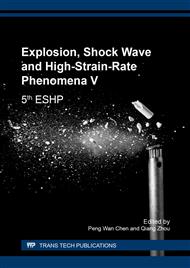[1]
S. Mroz, G, Stradomski, H. Dyja, Using the explosive cladding method for production of Mg-Al-bimetallic bars, Arch Civ and Mech Engg. 15 (2) (2015) 317- 323.
DOI: 10.1016/j.acme.2014.12.003
Google Scholar
[2]
S. Saravanan, K. Raghukandan, Diffusions kinetics in explosive cladding of dissimilar alloys as described through the Miedema Modal, Archives of Metallurgy and metals, 59 (4) (2014) 1615-1618.
DOI: 10.2478/amm-2014-0274
Google Scholar
[3]
L. Tricarico, R. Spina, D. Sorgente, M. Brandizzi, Effect of heat treatments on mechanic properties of Fe/Al explosion-welded structural transition joints, Mater Des. 30 (2009) 2693-270.
DOI: 10.1016/j.matdes.2008.10.010
Google Scholar
[4]
S. Saravanan, K. Raghukandan, Thermal kinetics in explosive cadding of dissimilar metals, Science and Technology of Welding and Joining, 17 (2) (2012) 99-103.
DOI: 10.1179/1362171811y.0000000080
Google Scholar
[5]
R. Kacar, M. Acarer, An investigation on the explosive cladding of 316L stainless steel- P355GH steel, J Mater Process Technol. 152 (2004) 91-96.
DOI: 10.1016/j.jmatprotec.2004.03.012
Google Scholar
[6]
M. Acarer, B. Demir, An investigation of mechanical and metallurgical properties of explosive welded aluminum-dual phase steel, Mater Lett. 62 (25) (2008) 4158-4160.
DOI: 10.1016/j.matlet.2008.05.060
Google Scholar
[7]
N. Kahraman, B. Gulenc, F. Findik, Corrosion and mechanical-micro structural aspects of dissimilar joints of Ti-Al-4V and Al plates, Int J Mater let. 34 (2007) 1432-1437.
DOI: 10.1016/j.ijimpeng.2006.08.003
Google Scholar
[8]
P. Tamilchelvan, K. Raghukandan, S. Saravanan, Kinetic energy dissipation in Ti-SS explosive cladding with multi loading ratios, Iranian Journal of Science and Technology Transactions of Mechanical Engineering 38 (M1) (2014) 91-96.
Google Scholar
[9]
S. Saravanan, K. Raghukandan, H. Hokamoto, Improved microstructure of dissimilar Cladding by means of interlayer technique, Arch civ Engg. 16 (2016) 563-568.
DOI: 10.1016/j.acme.2016.03.009
Google Scholar
[10]
S.A. A Akbari Mousavi, A. A Dashti, A. Halvaee, Effect of Operational parameters and Heat treatments on the Aluminium-Steel Explosively composite plates, Adv. Mater Research, Vol. 264-265 (2011) 223-228.
DOI: 10.4028/www.scientific.net/amr.264-265.223
Google Scholar
[11]
ASTM E 384-99, Standard Test for Micro indentation Hardness of Materials, ASTM International, (1999).
Google Scholar
[12]
MIL-J-24445A, Joint, Bimetallic Bonded, Aluminum to Steel, Department of Defense Military Specification, (1977).
Google Scholar
[13]
E. Elango, S. Saravanan, K. Raghukandan, Optimization of process parameters in Dissimilar explosive cladding through Taguchi method, J Manu Engg. 10 4 (2015) 194-199.
Google Scholar
[14]
R. Kacar, M. Acarer, Microstructure-property relationship in explosively welded duplex stainless-steel. Mat Sci Engg. A 363: (2003) 290-296.
DOI: 10.1016/s0921-5093(03)00643-9
Google Scholar
[15]
S. Saravanan, K. Raghukandan, Influence of interlayer in explosive cladding of dissimilar metals, Mat and Manu Processes 28 (5) (2013) 589-594.
DOI: 10.1080/10426914.2012.736665
Google Scholar
[16]
S. A Akbari Mousavi, P. Farhadi Sartangi, Experimental investigation of explosive welding of cp-titanium/AISI 304 stainless steel, Mater Des, 30 (2009) 459-468.
DOI: 10.1016/j.matdes.2008.06.016
Google Scholar
[17]
M. Honarpisheh, M. Asmabadi, M. Sedigi, Investigation of annealing treatment on the interfacial properties of explosive-welded Al/Cu/Al multilayer, Materials and Design, 37 (2012) 122 – 127.
DOI: 10.1016/j.matdes.2011.12.045
Google Scholar
[18]
Mohammad Hosein Bina, Farshid Dehghani, Mahmoud, Effect of heat treatment on bonding interface in explosive welded copper/stainless steel, Material and Design, 45 (2013) 504-509.
DOI: 10.1016/j.matdes.2012.09.037
Google Scholar


